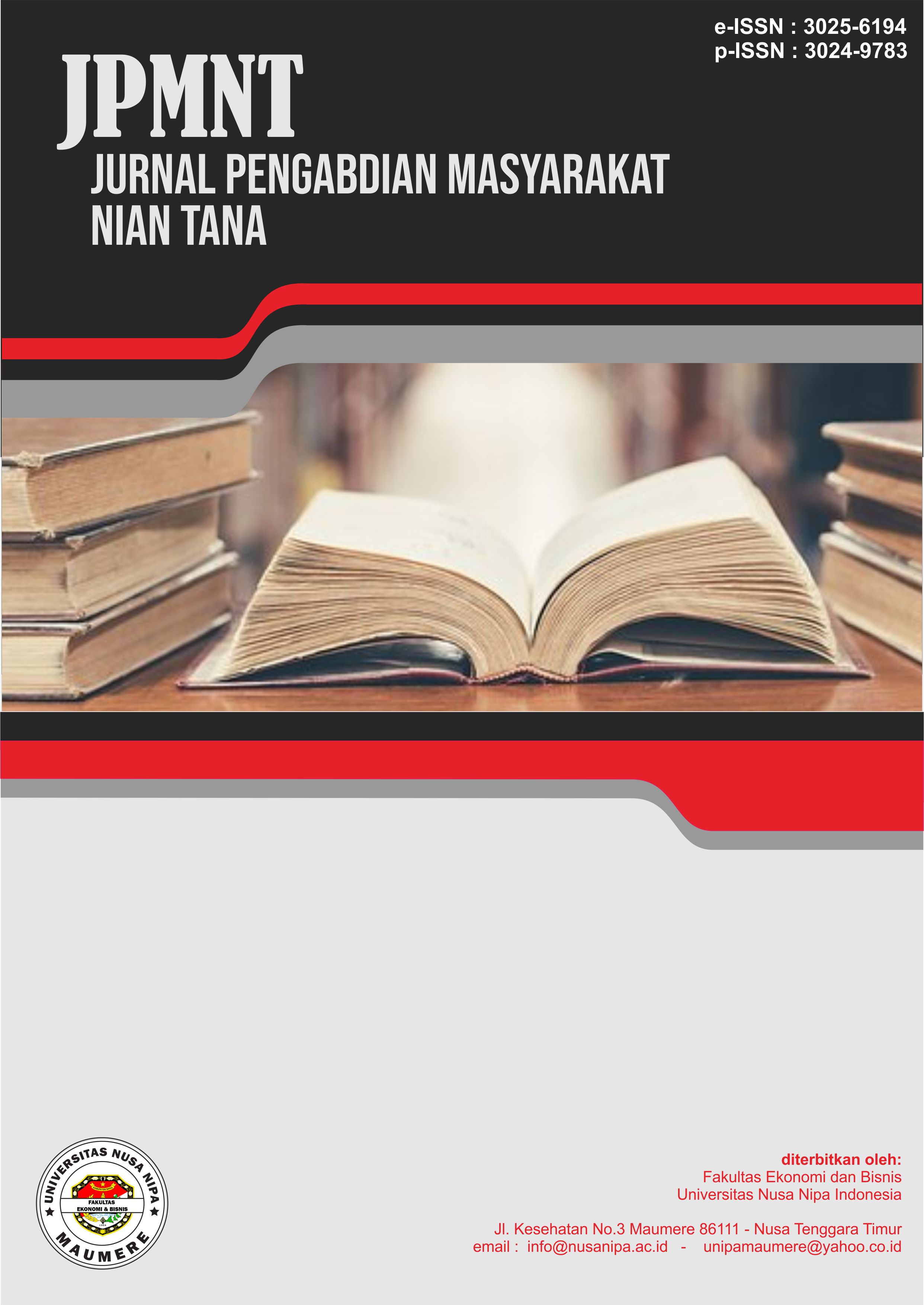Kegiatan Pengabdian Masyarakat dalam Rangka Pencegahan Hiperurisemia Melalui Pemeriksaan Asam Urat Sejak Dini pada Masyarakat Kelurahan Grogol
DOI:
https://doi.org/10.59603/jpmnt.v3i3.919Keywords:
Early-Detection, Elderly, Hyperuricemia, Uric-AcidAbstract
Uric acid (UA) is a waste product formed when the body breaks down purines, which are natural compounds found in the body and can be found in various types of foods such as alcohol, shellfish, and liver. Hyperuricemia is caused by increased uric acid production, decreased excretion, or a combination of both processes. Most people with hyperuricemia are asymptomatic (85% to 90%), but increased levels of uric acid in the blood or urine can cause gout or nephrolithiasis. Hyperuricemia and hyperuricosuria are also associated with other disorders such as metabolic syndrome, diabetes mellitus, cardiovascular disease, hypertension, atherosclerosis, obesity, and chronic kidney disease. The Community Service (PKM) activity held in Grogol Village, West Jakarta, aims to increase awareness of the elderly community regarding the importance of early detection of hyperuricemia. This program uses the Plan-Do-Check-Act (PDCA) approach, starting from planning uric acid level examinations and compiling educational materials, followed by implementing interactive screening and counseling, evaluating results, and following up in the form of medical referrals for participants with abnormal results. Of the 71 participants involved, only 1 person had uric acid levels above normal. Through education on low-purine diets, the importance of hydration, and physical exercise, this activity is expected to be able to reduce the incidence of hyperuricemia and its complications, as well as support the realization of a healthier elderly community that is aware of its metabolic health.
References
Adomako, E., & Moe, O. W. (2020). Uric acid and urate in urolithiasis: The innocent bystander, instigator, and perpetrator. Seminars in Nephrology, 40(6), 564–573. https://doi.org/10.1016/j.semnephrol.2020.12.003
Aupia, A. (2021). The effect of health education on the knowledge and adherence of diet for gout arthritis patients. Media Keperawatan Indonesia, 4(2), 120–126. https://doi.org/10.26714/mki.4.2.2021.120-126
Chen, F., Yuan, L., Xu, T., Liu, J., & Han, S. (2022). Association of hyperuricemia with 10-year atherosclerotic cardiovascular disease risk among Chinese adults and elders. International Journal of Environmental Research and Public Health, 19(11), 6713. https://doi.org/10.3390/ijerph19116713
Day, R. O., Lau, W., Stocker, S. L., Aung, E., Coleshill, M. J., Schulz, M., Bechara, J., Carland, J. E., Graham, G. G., Williams, K. M., & McLachlan, A. J. (2019). Management of gout in older people. Journal of Pharmacy Practice and Research, 49(1), 90–97. https://doi.org/10.1002/jppr.1511
Ejaz, A. A., Antenor, J. A., Kumar, V., Roncal, C., Garcia, G. E., Andres-Hernando, A., Lanaspa, M. A., & Johnson, R. J. (2022). Uric acid: A friend in the past, a foe in the present. Integrative Medicine in Nephrology and Andrology, 9(1), 8. https://doi.org/10.4103/2773-0387.348714
Ernawati, E., Adjie, E. K. K., Firmansyah, Y., Yogie, G. S., Setyanegara, W. G., & Kurniawan, J. (2023). Pengaruh kadar profil lipid, asam urat, indeks massa tubuh, tekanan darah, dan kadar gula darah terhadap penurunan kapasitas vital paru pada pekerja usia produktif. Malahayati Nursing Journal, 5(8), 2679–2692. https://doi.org/10.33024/mnj.v5i8.10414
George, C., Leslie, S. W., & Minter, D. A. (2023). Hyperuricemia. In Urology at a glance (pp. 107–109). https://doi.org/10.1007/978-3-642-54859-8_23
Kakutani-Hatayama, M., Kadoya, M., Okazaki, H., Kurajoh, M., Shoji, T., Koyama, H., Tsutsumi, Z., Moriwaki, Y., Namba, M., & Yamamoto, T. (2017). Nonpharmacological management of gout and hyperuricemia: Hints for better lifestyle. American Journal of Lifestyle Medicine, 11(4), 321–329. https://doi.org/10.1177/1559827615601973
Kim, C. S., Jin, D.-C., Yun, Y. C., Bae, E. H., Kwon, S., & Kim, S. W. (2017). Relationship between serum uric acid and mortality among hemodialysis patients: Retrospective analysis of Korean end-stage renal disease registry data. Kidney Research and Clinical Practice, 36(4), 368–376. https://doi.org/10.23876/j.krcp.2017.36.4.368
Lyu, X., Du, Y., Liu, G., Mai, T., Li, Y., Zhang, Z., & Bei, C. (2023). Prevalence and influencing factors of hyperuricemia in middle-aged and older adults in the Yao minority area of China: A cross-sectional study. Scientific Reports, 13(1), 10185. https://doi.org/10.1038/s41598-023-37274-y
Munir, M. I., Butt, Z. I., & Khan, A. (2024). Health benefits and consequences associated with uric acid among exercise performers. Pakistan Journal of Health Sciences. https://doi.org/10.54393/pjhs.v5i01.1268
Sari, T., Lumintang, V. G., Sukianto, L. A., Edbert, B., Gunaidi, F. C., & Santoso, A. H. (2024). Kegiatan penapisan pemeriksaan kadar asam urat terhadap hiperurisemia pada populasi lanjut usia. Jurnal Pengabdian Masyarakat, 3(1), 201–206.
Shan, R., Ning, Y., Ma, Y., Gao, X., Zhou, Z., Jin, C., Wu, J., Lv, J., & Li, L. (2021). Incidence and risk factors of hyperuricemia among 2.5 million Chinese adults during the years 2017–2018. International Journal of Environmental Research and Public Health, 18(5), 2360. https://doi.org/10.3390/ijerph18052360
Sim, A. S., & Goh, D. (2024). Deteksi dini dan penapisan kadar asam urat usia produktif di SMA Kalam Kudus II, Jakarta. JURAI: Jurnal ABDIMAS Indonesia, 2(2).
Singh, A., Santoso, A. H., Kawi, J. S., & Destra, E. (2025). Pemeriksaan rutin asam urat dalam rangka pencegahan timbulnya arthritis gout pada kelompok usia produktif di wilayah Krendang. JPMNT: Jurnal Pengabdian Masyarakat Nian Tana, 3(1), 45–54. https://doi.org/10.59603/jpmnt.v3i1.667
Skoczyńska, M., Chowaniec, M., Szymczak, A., Langner-Hetmańczuk, A., Maciążek-Chyra, B., & Wiland, P. (2020). Pathophysiology of hyperuricemia and its clinical significance – A narrative review. Reumatologia, 58(5), 312–323. https://doi.org/10.5114/reum.2020.100140
Timsans, J., Palomäki, A., & Kauppi, M. (2024). Gout and hyperuricemia: A narrative review of their comorbidities and clinical implications. Journal of Clinical Medicine, 13(24), 7616. https://doi.org/10.3390/jcm13247616
Yokose, C., McCormick, N., & Choi, H. K. (2021). The role of diet in hyperuricemia and gout. Current Opinion in Rheumatology, 33(2), 135–144. https://doi.org/10.1097/BOR.0000000000000779
Downloads
Published
How to Cite
Issue
Section
License
Copyright (c) 2025 Jurnal Pengabdian Masyarakat Nian Tana

This work is licensed under a Creative Commons Attribution-ShareAlike 4.0 International License.





